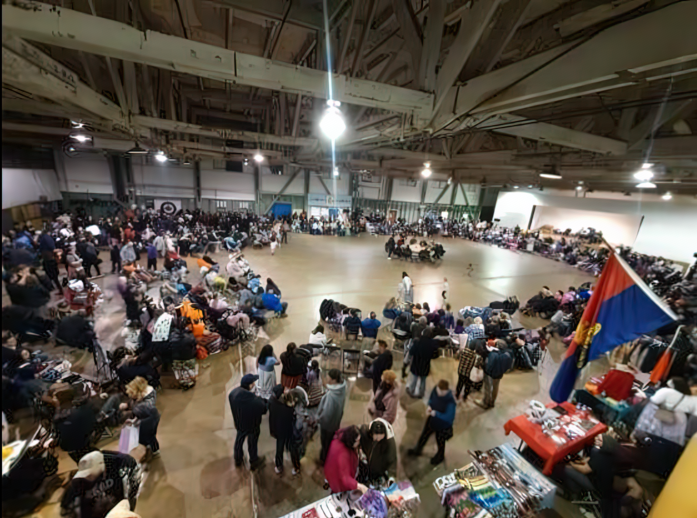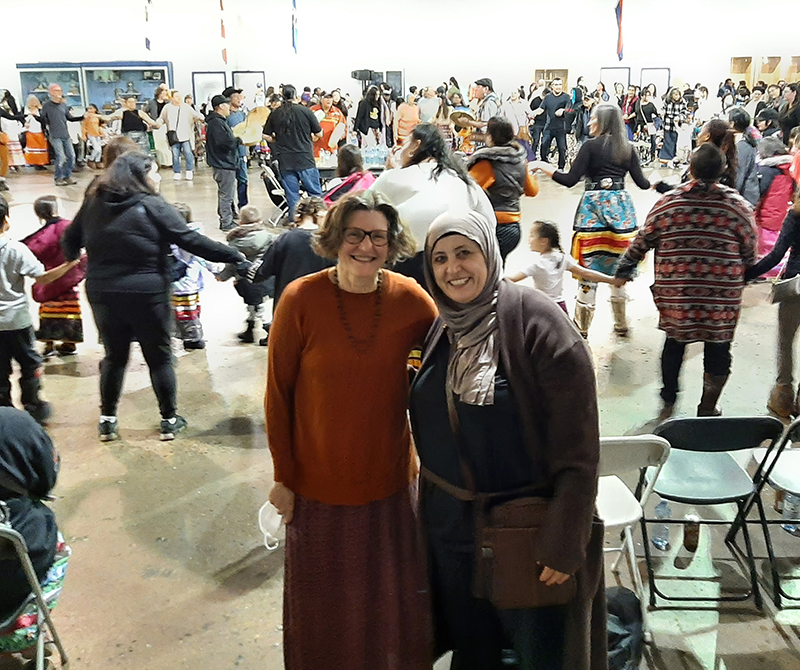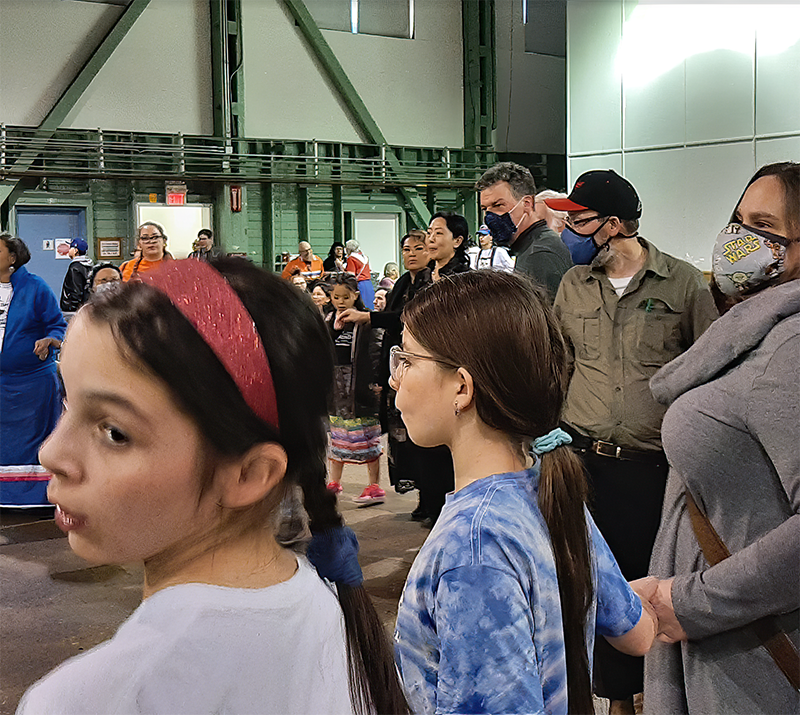
February 15thWhy do we celebrate communion with “wine” instead of soup?
As a follow-up activity to our most recent ACWAB (A Common Word Alberta) Interfaith dialogue, I suggested we, as Christians and Muslims show up at a Community Pipe Ceremony and Round Dance organized by Bent Arrow in Edmonton. Six Mennonites answered the call, and Salwa and her grandsons from the Muslim community. Salwa commented on how “warm and hopeful” the ceremony felt. Tim Wiebe-Neufeld and I were observing the communion-feel especially of the feast that followed the Pipe Ceremony.
The Pipe Ceremony began with an invitation for all who wanted, to smudge. The smudge is a way to purify the air, and to purify our being – our thoughts, our hearing, our words, what we see, and our hearts. As this was happening, two smaller circles formed in the middle of the large Aviation Museum hangar space, one for the men, led by a male elder, and one for women, led by a female elder. The rest of us were in a large circle surrounding these two smaller circles. Both circles did their own thing, passing around the pipe, and offering prayers for the community. As Tim observed, those of us sitting in the bigger outside circle were playing the role of witness. We were witnessing what I experienced as an offering of smoked tobacco, which is, from what I understand an offering to the the Creator of all things, and inviting the Creator to sustain us – all of us – Indigenous and Settler -- in our commitment to treaty principles.
When the prayers were finished, the feast began. We were served observing the following protocols:
- The elders who officiated the Pipe Ceremony were served first by the helpers. Then, the process of feeding the 400 began.
- Men did all the serving since the women had prepared the food (roles are very important in Indigenous culture, I have been told). Not all servers were indigenous – but all were allies.
- They went around the circle clockwise and were not supposed to go backwards – perhaps to honour the circle, and to ensure fairness.
- They served soup first, bannock second, oranges third, a rice and berry pudding next, followed by cookies and sweets
- We were instructed not to eat until all 400 of us had been served.
- The MC on stage was served last
- We were invited to eat together
- We were invited to put all uneaten food or peels into a bucket to honour the food we were eating by returning it to the earth
The whole experience reminded me of the Feeding of the 5000 – it didn’t look like there was enough food for all 400 of us, but the food kept coming around. All got fed!
This got me thinking: I understand why bread is so important in our communion ceremony, but why is the “fruit of the vine” so important in our communion tradition? Since our communion elements so clearly come from the Jewish foundation of our faith, I thought I would ask my Jewish husband. Every Friday night, we invite Shabbat – the Sabbath bride – into our home by lighting candles, allowing the smoke to wash over us, and blessing the wine and the bread. With that, the 24 hours of rest begin.
And so, I asked my husband “Why is it wine instead of – say, soup?”. He chuckled, and then shared an answer he learned from his Rabbi. “Wine represents joy!”, he said.
The protocols outlined gave a sacred and serious element to our communal feast, and yet there was so much joy. As we sat there holding our soup – which got more and more lukewarm as all were being served – I kept wondering how it will taste! When all were served and we were invited to eat, the soup tasted so very delicious! And the prayers leading up to the feast had created such a sacred and safe space for all of us.
After the feast, we cleaned up, put a few tables into the middle for the drummers, and the next part of the ceremony began: the community Round Dance. The joy was multiplying! For each iteration of the Round Dance, people would organically join the circle, breaking in as necessary, holding each others’ hands as equals. We were told that it is against protocol to hold a child in one’s arms as we dance, because that child is not an autonomous part of the circle.
Protocols give us such a beautiful framework to include guests. Protocols help us understand our role in the context of an activity from a cultural framework different from our own. I was so appreciative of the teachings around these protocols.
This has gotten me thinking about our protocols in our church communities. Are they named and intentional? Do we understand the meaning behind them? In one of our traditions – our communion service -- I have noticed the following protocols:
- The deacons or elders prepare and serve communion, and in the spirit of a servant, serve themselves – right after the pianist -- and the pastor last of all!
- In our Mennonite tradition, we often serve in the pews, and invite everyone to wait so that we can eat together
- There is a somber tone set, in the context of remembering the Last Supper, where Jesus foretells his impending arrest and execution.
- As North American Mennonites, we use grape juice instead of wine
- In the context of wheat allergies, we offer gluten free bread
- We sometimes hear music or sing together as people are served
- We sometimes reference communion as a love feast.
But do we experience communion as joy? Is there a way to integrate the Jewish understanding of the fermented fruit of the vine as God’s invitation to joy? Is Jesus’ invitation to remember him an invitation to embrace the joy of the resurrection? There is a hymn in the “love feast” section of our old bluer hymnal, the title of which is “I come with joy to meet my Lord.” Is this sentiment central to our communion services?
As we build intercultural capacity, I am wondering if we can examine our conscious and unconscious community protocols, so that we can interpret them well to people joining us. In doing so, we may well become more alert to protocols in communities different from our own, and thereby become better guests.
Ultimately, our New Testament scriptures invite us to consider carefully all of our community protocols, and to place them at the foot of the cross, with the knowledge of the resurrection, which unites us all across tribe and culture. It is only in the context of the cross that we are able to identify protocols that exclude, and replace them with protocols that include—in the spirit of discernment for inclusion so that all in our diverse community of Christians can together say, “Jesus is Lord!.”

